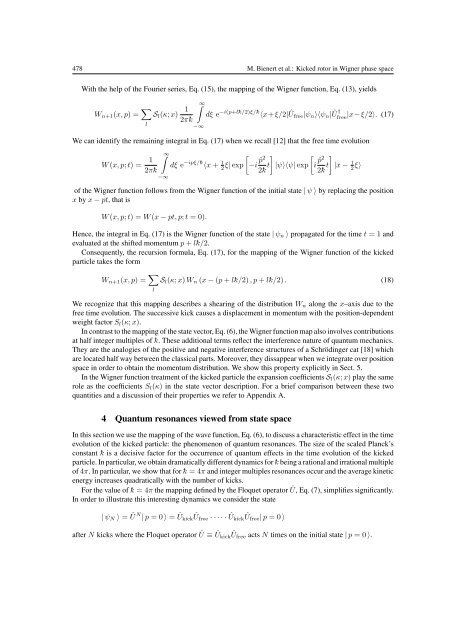Kicked rotor in Wigner phase space - The University of Texas at Austin
Kicked rotor in Wigner phase space - The University of Texas at Austin
Kicked rotor in Wigner phase space - The University of Texas at Austin
You also want an ePaper? Increase the reach of your titles
YUMPU automatically turns print PDFs into web optimized ePapers that Google loves.
478 M. Bienert et al.: <strong>Kicked</strong> <strong>rotor</strong> <strong>in</strong> <strong>Wigner</strong> <strong>phase</strong> <strong>space</strong><br />
With the help <strong>of</strong> the Fourier series, Eq. (15), the mapp<strong>in</strong>g <strong>of</strong> the <strong>Wigner</strong> function, Eq. (13), yields<br />
Wn+1(x, p) = <br />
Sl(κ; x) 1<br />
2πk- l<br />
∞<br />
−∞<br />
dξ e −i(p+lk- /2)ξ/k- †<br />
〈x+ξ/2|Ûfree|ψn〉〈ψn| Û free |x−ξ/2〉. (17)<br />
Wecan identify therema<strong>in</strong><strong>in</strong>g <strong>in</strong>tegral <strong>in</strong> Eq. (17) when werecall [12] th<strong>at</strong> thefreetimeevolution<br />
W (x, p; t) = 1<br />
2πk- ∞<br />
−∞<br />
dξ e −ipξ/k-<br />
<br />
1 〈x + 2ξ| exp<br />
−i ˆp2<br />
2k- t<br />
<br />
|ψ〉〈ψ| exp i ˆp2<br />
<br />
2k- t |x − 1<br />
2ξ〉 <strong>of</strong> the<strong>Wigner</strong> function follows from the<strong>Wigner</strong> function <strong>of</strong> the<strong>in</strong>itial st<strong>at</strong>e| ψ 〉 by replac<strong>in</strong>g the position<br />
x by x − pt, th<strong>at</strong> is<br />
W (x, p; t) =W (x − pt, p; t =0).<br />
Hence, the <strong>in</strong>tegral <strong>in</strong> Eq. (17) is the <strong>Wigner</strong> function <strong>of</strong> the st<strong>at</strong>e | ψn 〉 propag<strong>at</strong>ed for the time t =1and<br />
evalu<strong>at</strong>ed <strong>at</strong> the shifted momentum p + lk- /2.<br />
Consequently, the recursion formula, Eq. (17), for the mapp<strong>in</strong>g <strong>of</strong> the <strong>Wigner</strong> function <strong>of</strong> the kicked<br />
particletakes theform<br />
Wn+1(x, p) = <br />
Sl(κ; x) Wn (x − (p + lk- /2) ,p+ lk- /2) . (18)<br />
l<br />
We recognize th<strong>at</strong> this mapp<strong>in</strong>g describes a shear<strong>in</strong>g <strong>of</strong> the distribution Wn along the x–axis dueto the<br />
free time evolution. <strong>The</strong> successive kick causes a displacement <strong>in</strong> momentum with the position-dependent<br />
weight factor Sl(κ; x).<br />
In contrast to themapp<strong>in</strong>g <strong>of</strong> thest<strong>at</strong>evector, Eq. (6), the<strong>Wigner</strong> function map also <strong>in</strong>volves contributions<br />
<strong>at</strong> half <strong>in</strong>teger multiples <strong>of</strong> k - . <strong>The</strong>se additional terms reflect the <strong>in</strong>terference n<strong>at</strong>ure <strong>of</strong> quantum mechanics.<br />
<strong>The</strong>y aretheanalogies <strong>of</strong> thepositiveand neg<strong>at</strong>ive<strong>in</strong>terferencestructures <strong>of</strong> a Schröd<strong>in</strong>ger c<strong>at</strong> [18] which<br />
are loc<strong>at</strong>ed half way between the classical parts. Moreover, they dissappear when we <strong>in</strong>tegr<strong>at</strong>e over position<br />
<strong>space</strong> <strong>in</strong> order to obta<strong>in</strong> the momentum distribution. We show this property explicitly <strong>in</strong> Sect. 5.<br />
In the <strong>Wigner</strong> function tre<strong>at</strong>ment <strong>of</strong> the kicked particle the expansion coefficients Sl(κ; x) play thesame<br />
roleas thecoefficients Sl(κ) <strong>in</strong> the st<strong>at</strong>e vector description. For a brief comparison between these two<br />
quantities and a discussion <strong>of</strong> their properties we refer to Appendix A.<br />
4 Quantum resonances viewed from st<strong>at</strong>e <strong>space</strong><br />
In this section weusethemapp<strong>in</strong>g <strong>of</strong> thewavefunction, Eq. (6), to discuss a characteristic effect <strong>in</strong> thetime<br />
evolution <strong>of</strong> the kicked particle: the phenomenon <strong>of</strong> quantum resonances. <strong>The</strong> size <strong>of</strong> the scaled Planck’s<br />
constant k- is a decisivefactor for theoccurrence<strong>of</strong> quantum effects <strong>in</strong> thetimeevolution <strong>of</strong> thekicked<br />
particle. In particular, we obta<strong>in</strong> dram<strong>at</strong>ically different dynamics for k- be<strong>in</strong>g a r<strong>at</strong>ional and irr<strong>at</strong>ional multiple<br />
<strong>of</strong> 4π. In particular, weshow th<strong>at</strong> for k- =4πand <strong>in</strong>teger multiples resonances occur and the average k<strong>in</strong>etic<br />
energy <strong>in</strong>creases quadr<strong>at</strong>ically with the number <strong>of</strong> kicks.<br />
For thevalue<strong>of</strong> k- =4πthe mapp<strong>in</strong>g def<strong>in</strong>ed by the Floquet oper<strong>at</strong>or Û, Eq. (7), simplifies significantly.<br />
In order to illustr<strong>at</strong>e this <strong>in</strong>terest<strong>in</strong>g dynamics we consider the st<strong>at</strong>e<br />
| ψN 〉 = Û N | p =0〉 = Ûkick Ûfree ····· Ûkick Ûfree| p =0〉<br />
after N kicks where the Floquet oper<strong>at</strong>or Û ≡ Ûkick Ûfree acts N times on the <strong>in</strong>itial st<strong>at</strong>e | p =0〉.
















